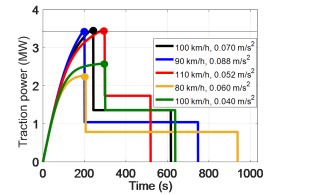Real time information applications and energy efficient solutions for rail freight (FR8HUB) (RV35)
Project Coordinator - Trafikverket
Project Leader at KTH - Mats Berg (WP1, WP4, WP6)
Scientists at KTH/WP6 - Zhendong Liu
Other Scientists - From 14 European Partners
Sources of Funding - Trafikverket and European Commission (Horizon 2020)
FR8HUB is to bring advanced technologies and digitalization processes to the rail freight market and consists of six work packages. The KTH Railway Group is participating in WP1 Migration plan, WP4 Intelligent video gate, and WP6 Freight loco of the future. The KTH involvement in WP6 is described below.
Traction power vs time for the five cases above
In WP6 KTH works on Task 6.4 Study implementation of power peak shaving. For smart electric power grids, power peak shaving is being used to avoid installation of capacity to supply peaks of variable loads. KTH works on smart train operation for which the power demand is reduced without changing the timetable (and other partners work on onboard energy storages). In contrast to ECO driving, aiming at reducing the energy usage, this approach will focus on studying the influence of train speed profile (driving style) reducing the amplitude of the highest power peaks without violating the timetable. For a given railway line, freight train and timetable, simulations are suggesting an optimized speed profile with respect to power demand and energy usage. It would be a simple and economical way for both infrastructure managers and train operators, especially in countries where the train operators have also to pay for high power demand, not only for the energy usage.
A simplified study was carried out to highlight the applied methodology. It assumes a synthetic track profile and freight train defined in EN 50591.
For a given Swedish railway line, power and energy simulations are carried out for a specified freight train running at different speed profiles but still with the same total running time. The KTH in-house software STEC is being used for this purpose. We are also using energy and GPS data recorded by the train’s energy meter, provided by Trafikverket, as a reference. An important issue is the ability to extract power demand as two-second samples from the energy meter.


